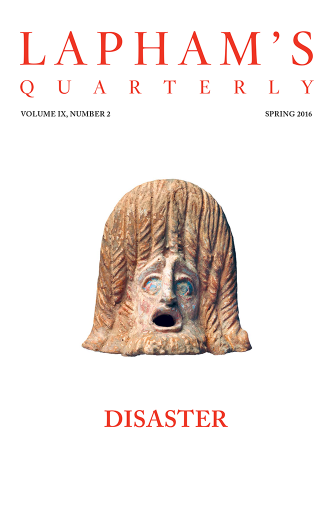Jazz is the result of the energy stored up in America.
—George Gershwin, 1933
Niagara Falls Ice Flow, by S.C. Baker, circa twentieth century. Smithsonian American Art Museum, gift of Herbert Waide Hemphill, Jr., 1998.
There’s a chilling irony in the subtitle of the first feature documentary film, 1922’s Nanook of the North: A Story of Life and Love in the Actual Arctic. With those words, director Robert Flaherty was clueing audiences in to how he was telling a romantic tale about his subject, while presuming it was fair game to refer to the Arctic setting as the “actual” part, as unmovable and fixed as a glacier, or what we might call factual today.
Yet these days anything that is presented as fact can be questioned or twisted. The faraway Arctic now resides in a place of abstraction, especially in the so-called debate about whether it is actually being irreparably damaged, as a geographical region on which the rest of the planet depends to remain healthy. In the screwy public discussion about climate change and what we need to do about our dependence on fossil fuels, the Arctic is something that is akin to myth. And that’s why, one hundred years after Nanook, documentary directors are banging their heads on the remaining ice floes and trying to use the tricks of their trade to convince us that the North Pole, and by extension the entire planet, is truly at risk of being destroyed—day by day, carbon-dioxide emission by carbon-dioxide emission—by modern life.
For many of us, a glimmer of hope emerged in 2006, when the documentary An Inconvenient Truth seemed to point the nation in the right direction. The film’s star and visionary, Al Gore, said, “Political will is a renewable resource.” And many of us believed it. One could see the ripples spreading from the film to the massive worldwide People’s Climate March of 2014, the eventual adoption of the Paris Agreement in 2015, and the ongoing grassroots organizing of the Sunrise Movement around the Green New Deal and beyond. It was a striking example of documentary’s power to collectively change, or at least help focus, minds.
How we got from Nanook to An Inconvenient Truth and the climate-change documentaries that have followed demonstrates the nonfiction form’s unique ability to persuade, entertain, and repel people. But as Truth’s influence recedes, we can now better see the extent and limitations of its powers.
Nanook has been hailed as the first of its kind, as it should be; it is a brilliant technical and creative achievement. It also exemplifies the genre’s greatest fault lines. What we have come to appreciate and to deride about Nanook has been passed on, as if in the cowlicks of its progeny, to the documentaries that have followed.
First, there is the question of whether it is really real. It is not as if things were just happening and Flaherty let his cameras roll—he had his subject, “Nanook,” reenact scene after scene. Perhaps, at the time, it didn’t matter. There were no rules or expectations for the form. The seal Nanook kills was already dead. The killing of the walrus was a fiasco: having grown unaccustomed to hunting such animals, the man portraying Nanook, along with his fellow Inuit, begged Flaherty to just shoot the darn thing. And Nanook wasn’t his real name but one chosen by Flaherty because he felt it was more cinematic than his actual name, Allakariallak.
These are just a few of the many examples of ways the truth was adjusted for the screen. Today, we like to think we know better. Documentaries come with a promise that they are nonfiction. But that can be a double-edged sword. When they work, they can be revelatory about the real world. But the pretense that they do so without any tweaking attaches to them a permanent cloud of falseness and doubt, leading to skepticism for some.
The second major fault is the presumption of objectivity, or at least fairness, in many documentaries. Yet Flaherty had no interest in appearing objective when he set out to expose the fact that the modern world was destroying the Inuit way of life in the Far North. “The urge that I had to make Nanook came from the way I felt about these people,” Flaherty wrote. “What I want to show is the former majesty and character of these people.”
Scottish social critic and filmmaker John Grierson gave this new, nonfictional application of cinema its name, documentary, in his 1926 review of Moana, Flaherty’s follow-up feature to Nanook, about native peoples living in Samoa. Grierson went on to define the genre as “the creative treatment of actuality,” which remains about as honest a description of the form as possible.
The Soviets had already found good use for film in burnishing their proletarian ideals—Sergei Eisenstein’s 1925 masterpiece Battleship Potemkin is the standout—which did not go unnoticed by Grierson. He wrote, “I look on cinema as a pulpit, and use it as a propagandist…Cinema is to be conceived as a medium, like writing, capable of many forms and many functions. A professional propagandist may well be especially interested in it. It gives generous access to the public. It is capable of direct description, simple analysis, and commanding conclusion, and may, by its tempo’d and imagistic powers, be made easily persuasive.”
While Grierson, working for early government film boards, first in Great Britain and then in Canada, produced documentaries valorizing the common worker, German filmmaker Leni Riefenstahl used the propagandistic powers of documentary to glorify Adolf Hitler and the Nazi Party and to support the Aryan myth with Triumph of the Will (1935). Riefenstahl’s film may be the ne plus ultra of documentaries designed to influence and control audiences, but it isn’t the only example. During World War II, the U.S. government also produced films representing its view of things—the ubiquitous newsreels, approved by the Office of War Information, that preceded theatrical feature films—which defined how Americans perceived the conflict.
Mercifully, perhaps, in the ensuing decades documentary took a more subtle place in shaping minds. State and government entities produced a multitude of educational documentaries on various subjects, from proper hygiene to correct social behavior. Duck and Cover, a 1952 film instructing American children in how to protect themselves in case of atomic war, comes to mind.
Nonfiction films were entering their green-spinach age: they were “good for you,” with heavy-handed narration and stilted re-creations, serving primarily as educational tools for schools, churches, and other community organizations. They were destined to be pushed around the plate by bored viewers. There was also a marginally more sophisticated wave of industrial films, made by companies to train their employees or inform the public, such as The American Road, produced in 1953 by the Ford Motor Company to celebrate its fiftieth anniversary.

Bugaku dancers, detail of a Japanese handscroll, seventeenth century. The Metropolitan Museum of Art, Seymour Fund, 1957.
The advent of television created a place for documentary series such as CBS’ See It Now, which first aired in 1951 as a kind of continuation of Edward R. Murrow and Fred W. Friendly’s Hear It Now radio series. Newsreel periodicals such as The March of Time had shown current events and history to movie-theater audiences since the 1930s, but television—with programs like the 1952 NBC series Victory at Sea, which depicted World War II battles—was displacing the cinema as the primary outlet for documentaries.
Walt Disney landed on a subject for a theatrically released documentary that would prove particularly popular: the natural world. His company released numerous nature films and a series of 1950s spin-offs called True-Life Adventures, about seals, birds, elk, lions, insects, and polar bears. The films were criticized by some for anthropomorphizing their subjects, rather than encouraging people to see the wild on its own terms. Despite (or, more likely, because of) Disney’s lack of scientific rigor—it was later revealed that a mass suicide of lemmings was fabricated for 1958’s White Wilderness, among other falsifications—the nature documentary became a leading genre of the form. The English also found success with televised nature films and series, and in particular with Zoo Quest (1954–64), a show hosted by a young naturalist named David Attenborough.
While these politically neutral films focused on big cats and fur seals, the documentary saw another significant, though less popular, development when a small group of filmmakers began to innovate more nimble, powerful methods, with lighter cameras and sync sound, that allowed a fly-on-the-wall perspective. They called it direct cinema or cinema verité, a nonfiction corollary to the fictional cinéma-vérité being made in France and Italy. Those documentaries of the late 1960s and early 1970s, directed by D.A. Pennebaker and the brothers Albert and David Maysles, among others, were primarily destined for small audiences on college campuses and in art houses, although some broke out to wider viewership, such as 1970’s Woodstock.
It’s quite a jump to go from Jimi Hendrix genuflecting onstage to a Ronald Reagan–era corporate CEO being chased by a populist firebrand, but I think it’s fair to say that the documentary’s next great phase in the United States, at least commercially—what many have called its golden age—began with Michael Moore’s 1989 personal polemic, Roger & Me. Here was a documentary that provided information, was raucously funny, and presented a deliberately subjective take on a serious issue: General Motors’ indifference toward the people of Flint, Michigan, where it was the largest employer. One could also make the case that Roger & Me successfully fulfills Grierson’s definition of cinema as a powerful tool of propaganda. The film was a revelation, making corporate greed a subject of national opprobrium, launching Moore’s career, and after grossing more than $6 million at the domestic box office, expanding the audience for documentary films.
But it took time for the form to reach its commercial zenith. There were other hits, such as Paris Is Burning (1990), Hoop Dreams (1994), and Crumb (1994), but it wasn’t until Moore’s 2002 film about gun control, Bowling for Columbine, which made a then-astounding $21 million at the U.S. box office and won an Academy Award—at a ceremony where Moore made an anti–Iraq War speech that sent his Q rating through the roof—that the documentary floodgates opened.
The year 2003 was a high-water mark for American documentaries as a vital cultural form. People flocked to theaters to watch everything from a cute spelling bee (Spellbound) to an unsettling depiction of child abuse (Capturing the Friedmans) and director Errol Morris cleverly putting the Vietnam War–era secretary of defense Robert McNamara in his place (The Fog of War). The following year saw the success of another highly manipulative and entertaining polemic, Super Size Me, in which Morgan Spurlock used the kind of stunt tactics Moore pioneered to change the way people perceived McDonald’s.
Meanwhile, nature documentaries didn’t need a renaissance. Wild Kingdom had been a successful part of Sunday-night television since the 1960s; when its popularity began to wane, the PBS show Nature took its place in 1982. The growth of cable channels provided a steady stream of flora and fauna on Discovery Channel, launched in 1985; Animal Planet, introduced in 1996; and the National Geographic Channel, which began airing in 2001. Attenborough had become a household name. After the 2001 French film Winged Migration was released in the United States in 2003, its success spurred a string of nature documentaries that did well at the box office, starting with the monumentally successful March of the Penguins in 2005.
Despite decades of development expanding what the documentary could do, the form didn’t significantly tackle the subject of climate change until the twenty-first century—not that there hadn’t been a smattering of attempts. In fact, one particular jewel, The Unchained Goddess, was released in 1958, long before the environmental movement coalesced around the issue.
The Unchained Goddess was part of the Bell System Science Series made by AT&T for television and later shown in classrooms. This educational documentary, which was produced by Hollywood legend Frank Capra, features a scientist and a writer discussing the weather and the planet’s meteorological patterns while animated characters chime in. The planet’s weather is given a female persona, Meteora, who swoons for one of the nice men narrating the show. At the end of the film, the scientist clearly identifies the peril of global warming based on the then-emerging science about carbon-dioxide emissions. “Man may be unwittingly changing the world’s climate through the waste products of his civilization,” and a rise in temperatures might mean mass flooding of the United States, he says, and jokes that that could lead to Americans looking down at drowned cities through glass-bottom boats.
The film ends on an optimistic note. “If the questions are there, because they are there, man will answer them,” the scientist says. “Man would eventually resolve them. Not for conquest, but so that he could live hand in hand with nature.”
The film was an early warning, but one without any sense of urgency. Other made-for-television and classroom documentaries about global warming would follow, but nothing electrified the culture. (Does anyone remember 1981’s Warming Warning or 1999’s Turning Down the Heat: The New Energy Revolution?)
And yet popular awareness of global warming and the need to act was slowly building—from the first Earth Day, in 1970, through the 1997 Kyoto Protocol, when dozens of nations agreed that climate change was happening and that it was caused by humans. President Bill Clinton signed the agreement. The Senate, however, never ratified it.

Both Members of This Club, by George Bellows, 1909. National Gallery of Art, Chester Dale Collection.
By 2005 the public’s concern about climate change and the renaissance in documentaries were reaching mutual climactic points. Several nonfiction films were set to release that year and the following one, including Global Warming: The Signs and the Science, Five Ways to Save the World, and Attenborough’s Are We Changing Planet Earth?, but it was An Inconvenient Truth that became the centerpiece of a national discussion. Greenpeace executive director Annie Leonard credits the film with shifting American consciousness about the peril of climate change on a scale similar to the impact of Rachel Carson’s 1962 book, Silent Spring, which enlightened an earlier generation about the environmental harms of pollution. Truth made $24 million at the domestic box office. The release was covered extensively by the media: Al Gore spoke at the Academy Awards to an audience of tens of millions of Americans, and the film’s success positioned him to win the Nobel Peace Prize in 2007.
Accepting the Oscar for best documentary feature, Gore riffed on a line from the film: “We need to solve the climate crisis. It’s not a political issue. It’s a moral issue.” It was a succinct and impassioned plea, and one that deftly recast climate change to make it accessible to a wide audience. It was also—however much you or I may agree with the sentiment—propaganda.
An Inconvenient Truth is an example of Grierson’s belief in documentary’s potential as a “pulpit.” It simplified a complex issue, reached a lot of people, and was “made easily persuasive.”
When Grierson called documentaries propaganda, he wasn’t using the word pejoratively. He was applying a literal definition of the word: “the spreading of ideas, information, or rumor for the purpose of helping or injuring an institution, a cause, or a person.” The definition encompasses propaganda put to both noble and ignoble purposes, but we more commonly think of it as solely deceitful, intending to mislead and propagate lies. When Grierson produced documentaries that demonstrated the dignity of the common worker, he didn’t think he was being untruthful. He was just trying to be persuasive.
Gore and Truth director Davis Guggenheim were also trying to persuade their audience by structuring the film around a masterfully clear and compelling mixture of personality, powerful optics, and facts. Though the focus of the film is literally a recording of Gore delivering a slideshow presentation about global warming, it doesn’t feel like it. We watch the notoriously stiff, technocratic Gore point at the numbers, ride a forklift, and make self-deprecating jokes. We travel with him as he goes on his crusade to educate the world. We see shocking charts and statistics that demonstrate the catastrophic changes in carbon-dioxide levels and global temperatures, with Gore repeatedly referring to the scientists whose work backs up his assertions. The most powerful images are the ones of destruction and mayhem, natural disasters such as ice caps melting and human life imperiled, from floods in India and China to Hurricane Katrina in Louisiana.
An Inconvenient Truth helped galvanize activism in response to climate change. It’s impossible to measure the exact impact, but it’s commonly thought that the film had a significant effect on the emerging climate movement, culminating in worldwide demonstrations in 2014—heck, Swedish wunderkind Greta Thunberg partly credits Truth for inspiring her launch into activism.
Other climate-change documentaries followed, including No Impact Man (2009), Earth Days (2009), The Island President (2011), Chasing Ice (2012), Thin Ice (2013), Racing Extinction (2015), This Changes Everything (2015), Antarctica: Ice and Sky (2015), Chasing Coral (2017), and The Hottest August (2019). Leonardo DiCaprio produced several climate-change documentaries, including The 11th Hour (2007) and Before the Flood (2016).
But after the initial jolt of An Inconvenient Truth, these films did not inspire the mass interest or action sparked by their predecessor. The director Louie Psihoyos promoted his film Racing Extinction (2015) by projecting images of endangered animals onto the Empire State Building. Psihoyos told me why he sought a larger audience: “To create a tipping point, you probably need 10 percent of the population. With the film and this event, we are trying to reach that number. If you hit that number, then you have a chance of moving the needle.” But Racing Extinction fizzled at the box office, and though it later found a respectable television audience on Discovery, the film didn’t move the needle.
Fire destroys that which feeds it.
—Simone Weil, 1940The only environmental documentary since An Inconvenient Truth that seems to have had a significant effect on the national conversation was 2010’s Gasland, about the dangers of fracking, in which gas is extracted from the earth by injecting high-pressure water and other materials into the bedrock. It made a meager thirty thousand dollars in U.S. theaters but found far more viewers on HBO, riding a wave of press coverage that recast fracking as a hot-button issue in the public discussion about fossil-fuel energy.
Perhaps it was the newness of the issue of fracking that helped Gasland catch on. But much credit must also go to the film’s director, Josh Fox, who borrows directly from the Michael Moore toolbox. Fox positions himself as the on-camera common man who is not getting answers from the powers that be, and uses provocative demonstrations, such as setting fire to the gas-infused running water near fracking sites.
Despite the increasing momentum and clear need for action on climate change, why have no other documentaries had the impact of An Inconvenient Truth or even Gasland? It could well be that the increasing prominence of the issue has made documentaries on the subject less powerful. Anyone who cares enough to do anything about the crisis is already aware of it. The net effect of a documentary on the subject may well have been diminished, limiting the persuasive potential envisioned by Grierson. Gore’s An Inconvenient Sequel: Truth to Power, which came out in 2017, was less an attempt to persuade the unconcerned and more a review of what had changed in the previous ten years.
I’d contend that nonfiction filmmakers’ climate-change messages have become background noise and that recent films are merely preaching to the converted. For those who are interested, there’s always something new on PBS (The Age of Nature, Changing Planet, the NOVA episode “Can We Cool the Planet?”). And in nature documentaries, warnings about climate change are common. In the series Our Planet, released in 2019, narrator Attenborough leads with dire warnings about humankind’s destruction of the earth, along with a reminder that “with our help, the planet can recover.” Netflix claims that 100 million households have seen it.
Nothing exemplifies the representation of global warming in the United States today better than the ubiquitous greenwashing ads by companies such as BP (rebranded from British Petroleum) and Toyota. These companies that accelerated climate change now offer new, improved products that are purported to help slow its impact. Global warming is now a marketing opportunity.

Dancing Dervishes, detail of a folio from the Shah Jahan Album, c. 1610. The Metropolitan Museum of Art, purchase, Rogers Fund and The Kevorkian Foundation Gift, 1955.
Concern about climate change is split between two opposing teams. One team knows it’s happening and believes something should be done about it. The other team is more like…meh. In a 2021 Pew Research Center survey, 94 percent of Americans who identify politically with the left said that they were willing to modify how they live in order to reduce the effects of climate change. Of those who identify with the right, only 45 percent said that they were willing to do the same. The survey found that from 2015 to 2021, the percentage of Americans who were concerned about being personally harmed by climate change decreased, from 30 percent to 27 percent. Again there was a political divide: liberals were more concerned than conservatives were by a gap of 59 percent.
During the 2016 U.S. presidential election, aided and abetted by cable channels on both ends of the political spectrum, climate change became a culture-war issue akin to abortion or gun control. No Democratic candidate diverged from the scientific consensus that climate change is happening and is caused by humans. Although several Republican candidates acknowledged the existence of climate change, most were skeptical or adamantly opposed to the idea that it was man-made. Former Texas governor Rick Perry declared it a “contrived, phony mess,” while Texas senator Ted Cruz said, “The global-warming alarmists are the equivalent of the flat-earthers.” Donald Trump called global warming “bullshit.” This is not so surprising. Yale Law School professor Dan Kahan explains in a 2007 paper that “individuals subconsciously resist factual information that threatens their defining values.” In a 2015 interview, Kahan pointed out that “positions on climate change have become symbols of whose side you are on in a cultural conflict divorced from science.” For politicians financially supported by the fossil-fuel industry and neck-deep in the culture of Big Oil, a skeptical position on climate change is self-serving.
Could nuclear power be a subject in the conversation about energy and climate change that is less tied to these political teams? Republicans have been open to the use of nuclear energy for some time, though they haven’t taken the lead on the issue. And for the first time in almost fifty years, the Democratic Party included a pronuclear statement in its 2020 platform.
Environmental groups such as Greenpeace and the Sierra Club remain adamantly opposed to nuclear power, but it seems reasonable to expect that as the rate of climate change increases and the projections worsen beyond the capacity of wind and solar power to address them, more people will be receptive to the option of nuclear energy.
Back in 2013, the documentary Pandora’s Promise tried to change our understanding of nuclear power. Director Robert Stone, a seasoned filmmaker with a long-standing interest in the environmental movement going back to the 1970s, argued that nuclear power was reasonably safe, with a smaller carbon footprint and fewer long-term costs than fossil fuels; most important, it was more capable of meeting the planet’s demand for energy than any other resource. Stone believes that the risk of nuclear disaster is manageable and that concerns about nuclear-waste storage are exaggerated, leading him to make the sort of “commanding conclusion” that Grierson recommended for effective propaganda. Pandora’s Promise helped motivate a new strain of pronuclear activists—from skeptics and freethinkers to concerned parents and nuclear academics—in the environmental movement, but it was far from a popular hit.
Stone has most recently executive-produced Atomic Hope, a 2022 documentary directed by Frankie Fenton that depicts the struggles of pro-nuclear activists, many of whom were influenced by Pandora’s Promise. Nuclear Now, a documentary by Oliver Stone (no relation to Robert), came out in the United States this spring. It makes similar attempts to promote atomic energy, but with a strong dose of the director’s moxie, including allegations that the Rockefeller family seeded many antinuclear myths, such as the claim that low levels of radiation cause significant health risks, in order to take down a competitor of Big Oil.
Is it a fact—or have I dreamed it—that, by means of electricity, the world of matter has become a great nerve, vibrating thousands of miles in a breathless point of time?
—Nathaniel Hawthorne, 1851Neither film is likely to be the next An Inconvenient Truth, revolutionizing the cultural conversation around energy. But could the fact that they don’t align with a preexisting team make those inclined to ignore or even deny climate change more receptive to the discussion about how we’re going to power the planet without destroying it?
Expecting tangible, global change from a particular documentary may be the wrong way to look at Nanook of the North’s descendants, however. Nature documentaries have allowed us to behold the world beyond our couches and movie-theater seats as it is (and was). Climate-change documentaries have, in turn, made the case that the earth is worth fighting for. They have allowed us to bear witness to our planet and, however grim this may sound, to its demise.
An Inconvenient Truth might have realized the documentary’s potential as a persuasive tool. But it also displayed the limits of the form. Without a political apparatus that responds to the will of the people—led by scientists, activists, NGOs, and, of course, local and federal governments with mandates to combat global warming—even the greatest climate-change documentary won’t stem the tide.




